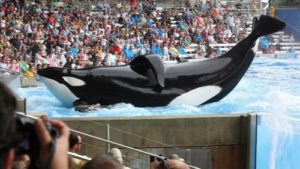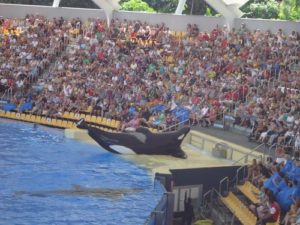SeaWorld made an announcement today that Tilikum, the killer whale at the center of attention of the documentary, Blackfish, died early this morning. The famous orca had been ill since March 2016 when it was announced he was suffering from a drug-resistant bacterial lung infection. “He has a disease which is chronic and progressive,” a SeaWorld vet explains in a video. “We have not found a cure.”
It is a sad ending for a killer whale who garnered worldwide attention but lived in captivity the size of bathtub (he was confined to a tank containing 0.00001 percent of the quantity of water that he would travel in a single day in the ocean) never knowing freedom after the age of 2. He grew to weigh 12,000 lbs. and 22 feet in length. While the news is sad, I choose to see it as Tilikum is finally free.
Tilikum was captured off Iceland in November 1983 when he was only two years old. He was ripped away from his mother and family in the ocean and forced to live in captivity for 34 years. He had been living at SeaWorld Orlando for the past 25 years.
The world learned of Tilikum, the largest orca in history, in 2010 when he brutally killed SeaWorld trainer, Dawn Brancheau by scalping her, breaking many bones and eventually drowning her. This was the third and last person’s death for which he was responsible. He killed Sealand trainer, Keltie Byrne in 1991 and a man, Daniel Dukes, who trespassed into SeaWorld in 1999. It is believed Dukes was drowned by the killer whale after being treated aggressively. Tilikum was swimming with Dukes on him the next morning. It is also believed there was camera footage but none has ever been released.
Despite the brutality of these deaths, many weren’t angry with Tilikum. The world would soon learn the truth of killer whales kept in captivity through the 2013 documentary, Blackfish. After the film was shown in its entirety on CNN, the public became outraged over the way killer whales were treated by SeaWorld. The documentary focused on Tilikum and the other killer whales and their cruel treatment in captivity. “It also challenged us to consider our relationship to nature and reveals how little we humans have learned from these highly intelligent and enormously sentient fellow mammals.”
Tim Zimmerman, Associate Producer/Co-Writer for Blackfish was my television guest in April 2016 where we discussed the ending of SeaWorld’s captive orca program and what it meant for the future of SeaWorld. Tim has followed Tilikum’s life since 2010 when Brancheau was killed. He has also authored, “The Killer in the Pool,” and “The Blood in the Water.” Both center on the death of the deceased trainer. You can view the show with Tim here.
Gabriela Cowperthwaite, director of Blackfish, statement on Tilikum’s death:
“Tilikum’s life was so incredibly tragic. He experienced unspeakable pain, he caused unspeakable pain, so at least his chapter is over. Now we have to turn our attention to retiring the other whales to an ocean sanctuary. Because this business of holding whales in concrete tanks is so clearly a model where no one wins.”
Statement from Dogwoof:
“Heartbreaking news today as SeaWorld announces the passing of Tilikum. The orca featured heavily in our 2013 film Blackfish and has since become a name synonymous with the species. Blackfish was a defining film for Dogwoof and a title we are extremely proud to represent.”
The film was hugely influential and created a worldwide outcry for the release of Tilikum and other orcas. SeaWorld stock and attendance plummeted as a result of what is commonly referred to as the ‘Blackfish Effect’, eventually causing SeaWorld to make changes to breeding policies and shows.
According to SeaWorld’s website, “Tilikum was surrounded by the trainers, care staff and veterinarians that provided him around-the-clock world-class care. Tilikum’s veterinarians and caretakers delivered various treatment regimens over the course of this illness, which consisted of, among other things, combinations of anti-inflammatories, anti-bacterials, anti-nausea medications, hydration therapy and aerosolized antimicrobial therapy.”
“Like all older animals, Tilikum had faced some very serious health issues. While the official cause of death will not be determined until the necropsy is completed, the SeaWorld veterinarians were treating a persistent and complicated bacterial lung infection. The suspected bacteria is part of a group of bacteria that is found in water and soil both in wild habitats and zoological settings. ”
“Tilikum had, and will continue to have, a special place in the hearts of the SeaWorld family, as well as the millions of people all over the world that he inspired,” said President & CEO of SeaWorld Joel Manby. “My heart goes out to our team who cared for him like family.”
“Tilikum became a part of SeaWorld’s family 25 years ago. Estimated to be about 36 years old, Tilikum was near the high end of the average life expectancy for male killer whales according to an independent scientific review.”
I disagree with Mr. Manby’s statement. Male orcas can live to be 50-60 years old.
“While today is a difficult day for the SeaWorld family, it’s important to remember that Tilikum lived a long and enriching life while at SeaWorld and inspired millions of people to care about this amazing species.”
To say Tilikum had an enriching life is to ignore what Blackfish had revealed to the world: Tilikum and other killer whales endured cruel treatment at the hands of SeaWorld. Forcing them to live a life of small confinement is not enriching and does not teach the public about this beautiful species. I do believe those did take care of him in his later years and some even in his earlier years genuinely cared about Tilikum and saw how unfair his life was. Since Brancheau’s death, trainers came to his defense and watched out for him knowing he would be isolated even more.
Ironically, SeaWorld writes on their website that “the ocean is home to killer whales. Like us, killer whales are dependent on a healthy ocean.”
If only they realized and accepted this reality decades ago. Tilikum leaves behind 10 calves he sired out of a total of 21.
#RIPTilikum



I personally am glad Tilikum is out of his life of misery. All the killer whales who have been forced to live at SeaWorld their entire lives lead miserable lives. They should be set free in ocean sanctuaries. Tilikum has had it worse than others because of the deaths which SeaWorld is ultimately responsible for. You’re free to swim, Tilly! Be free and at rest. I’m so sorry greed won over humanity. #RIPTILIKUM
Ripped from his mom, used for “entertainment” purposes to become rich and greedy, Tilikum lived and died at the hands who did this to him. Free at last. :’)
I think you wanted a sad face. :'( Maybe not.
SeaWorld’s statements on Tilikum’s death are the epitome of hypocrisy.
Blackfish exposed the facts about kiiler whales in captivity. What they’ve done is cruel and to say Tilikum’s had an enriching life is adding insult to injury. Had it not been for SeaWorld Tilikum wouldn’t have been confined,held captive and die young. A life of chains is over for this orca but there are still too many left in their possession. Terribly wrong and criminal.
#tears4tilikum
?
Tilikum and other orcas who lived, live and died at SeaWorld were/are forced to live a life of misery. I honestly believe there were many trainers, including Dawn Brancheau, who deeply cared about the welfare of the killer whales including Tilikum. SeaWorld was so desperate they initially blamed Dawn for her own death. Tilikum is the most aggressive killer whale in captivity and because of that, he had to live a solitary life for years. It wasn’t his fault but the fault of those who saw dollar signs. Forced to perform like clowns for a crowd, they sometimes were deprived of food if they didn’t perform to expectations. This is cruel. Saying Tilikum had an enriching life is as stupid as blaming Dawn for her own death. SeaWorld can’t take responsibility for their awful actions. Tilikum deserved better as do the other orcas. Orcas live in pods with relatives. Tilikum never saw his family again. Instead, he was forced in pools with other orcas who tortured him and SeaWorld saying all the orcas are now family. This clearly shows how they were out for profits and not for the good of Tilikum and the other killer whales. Release the other orcas into sea sanctuaries. Don’t deprive them as you have with the others. I’m glad you’re free from your hell, Tilly.
Tilikum could’ve lived closer to 50 or 60 in the ocean not 36.
If they knew and know the ocean is where killer whales belong,why did and do keep so many in captivity? What an odd statement coming from a profit driven amusement park where animals performed stunts instead of living a real life.
Very sad. 🙁
SeaWorld should be ashamed of themselves for keeping orcas in captivity. They’re not. Only forced to do because of public pressure and dropping sales.